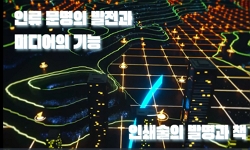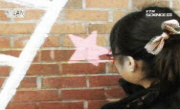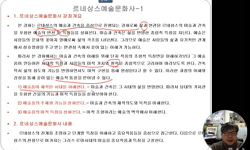It has been more than 30 years since Korean academia started studying the art history related to Dunhuang Caves. The research results have been derived since 1981, and it is precisely 39 years old. Although the period of research is quite long, the re...
http://chineseinput.net/에서 pinyin(병음)방식으로 중국어를 변환할 수 있습니다.
변환된 중국어를 복사하여 사용하시면 됩니다.
- 中文 을 입력하시려면 zhongwen을 입력하시고 space를누르시면됩니다.
- 北京 을 입력하시려면 beijing을 입력하시고 space를 누르시면 됩니다.

한국의 돈황 불교미술 연구 동향: 사고틀의 새로운 모색 = Research Trends of Dunhuang Buddhist Arts in Korea: A New Seek for a Framework of Thinking
한글로보기부가정보
다국어 초록 (Multilingual Abstract)
In the latter half of the 20th century, when Mogao Grottos in Dunhuang first began to be interested, the mural paintings and sculptures of Mogao Grottos in Dunhuang, which were even unfamiliar to the intellectuals, have grown greatly into an international discipline that now has a deep interest in the general public. This article attempts to explore the perspectives of Korean researchers on Dunhuang Buddhist arts, a treasure house for Buddhist art researchers, and examine what they have accomplished and what they mean. This article also attempts to investigate how research of Dunhuang Buddhist arts in Korea is different from that of China and Japan. At this point, about 30 years since Korean academia started to get interested, it is said that looking back at research in the past is meaningful work to revitalize research in the future.
It has been more than 30 years since Korean academia started studying the art history related to Dunhuang Caves. The research results have been derived since 1981, and it is precisely 39 years old. Although the period of research is quite long, the results of research on Buddhist arts of Dunhuang Caves were more than expected. There are about 120 studies that I have grasped to date. As a matter of fact, this number is not only for studies in the Buddhist art history perspective but rather for all of the research achievements of 'Dunhuang related research history', and ‘costumes history, architects history, and conservation sciences for Dunhuang Buddhist arts'. Of the more than 120 research achievements, there are only 23 research achievements for the past 20 years from 1981 to 2000, and the remaining 100 are obtained from 2000 to 2018. In the meantime, it should be said that the studies on Buddhist arts in Dunhuang Caves started in earnest after year 2000 when exchanges between Korea and China became active and the field survey became easier after reform and opening.
In the latter half of the 20th century, when Mogao Grottos in Dunhuang first began to be interested, the mural paintings and sculptures of Mogao Grottos in Dunhuang, which were even unfamiliar to the intellectuals, have grown greatly into an international discipline that now has a deep interest in the general public. This article attempts to explore the perspectives of Korean researchers on Dunhuang Buddhist arts, a treasure house for Buddhist art researchers, and examine what they have accomplished and what they mean. This article also attempts to investigate how research of Dunhuang Buddhist arts in Korea is different from that of China and Japan. At this point, about 30 years since Korean academia started to get interested, it is said that looking back at research in the past is meaningful work to revitalize research in the future.
참고문헌 (Reference)
1 권영필, "중앙아시아 속의 고구려인 발자취" 동북아역사재단 2008
2 김리나, "이기백선생고희기념 한국사학논총(상)" 일조각 507-513, 1994
3 김혜원, "우훙의 중국미술사 연구 -미국의 중국미술 연구의 학문적 성장과 관점의 변화" 미술사와 시각문화학회 (6) : 110-133, 2007
4 Kira Samosyuk, "올덴부르크 컬렉션의 막고굴 유물"
5 노태돈, "예빈도에 보인 고구려" 서울대학교 출판부 9-15, 2003
6 김원룡, "아프라시압 宮殿壁畵의 使節圖" 129-130 : 162-167, 1976
7 이재성, "아프라시압 宮殿址 壁畵의 ‘鳥羽冠使節’에 관한 고찰― 高句麗에서 사마르칸드(康國)까지의 路線에 대하여 ―" 중앙아시아학회 18 (18): 1-34, 2013
8 국립문화재연구소 미술문화재연구실에서, "실크로드 연구사전: 동부(중국 신장)"
9 권영필, "실크로드 미술 ―중앙아시아에서 한국까지" 열화당 98-99, 1997
10 크레그 클루나스, "새롭게 읽는 중국의 미술" 시공아트 106-, 2007
1 권영필, "중앙아시아 속의 고구려인 발자취" 동북아역사재단 2008
2 김리나, "이기백선생고희기념 한국사학논총(상)" 일조각 507-513, 1994
3 김혜원, "우훙의 중국미술사 연구 -미국의 중국미술 연구의 학문적 성장과 관점의 변화" 미술사와 시각문화학회 (6) : 110-133, 2007
4 Kira Samosyuk, "올덴부르크 컬렉션의 막고굴 유물"
5 노태돈, "예빈도에 보인 고구려" 서울대학교 출판부 9-15, 2003
6 김원룡, "아프라시압 宮殿壁畵의 使節圖" 129-130 : 162-167, 1976
7 이재성, "아프라시압 宮殿址 壁畵의 ‘鳥羽冠使節’에 관한 고찰― 高句麗에서 사마르칸드(康國)까지의 路線에 대하여 ―" 중앙아시아학회 18 (18): 1-34, 2013
8 국립문화재연구소 미술문화재연구실에서, "실크로드 연구사전: 동부(중국 신장)"
9 권영필, "실크로드 미술 ―중앙아시아에서 한국까지" 열화당 98-99, 1997
10 크레그 클루나스, "새롭게 읽는 중국의 미술" 시공아트 106-, 2007
11 권영필, "렌투스 양식의 미술" 사계절 232-239, 2002
12 岡田健, "동서문화 교류의 증거인 돈황 벽화의 보존"
13 권영필, "동서문명의 십자로-우즈베키스탄의 고대문화" 국립중앙박물관 248-261, 2009
14 고려대학교 민족문화연구소 돈황학센터, "돈황학대사전" 소명출판사 2016
15 서용, "돈황벽화 모사기법 연구"
16 권영필, "돈황과 한국-나의 체험적 돈황미술기(敦煌美術記)를 바탕으로"
17 李最雄, "돈황 막고굴의 현황과 보존 문제"
18 Jacques Gies, "기메박물관 펠리오 컬렉션 소장의 돈황 <화엄경변(華嚴經變)>에 대한 고찰"
19 빅터 메이어, "그림과 공연-중국의 그림 구연과 그 인도 기원" 소명출판 2012
20 Susan Whitfield, "국제돈황프로젝트와 영국 소장의 중앙아시아 자료"
21 深津行德, "臺灣故宮博物院所藏『梁職貢圖』模本について, 『朝鮮半島に流入した諸文化要素の硏究(2)" 學習院大學東洋文化硏究所 41-99, 1999
22 문명대, "李載昌博士還曆紀念 한국사학논총" 한울 1990
23 李新, "敦煌石窟古代朝鲜半岛人物图像调查研究, 敦煌和丝绸之路国际学术研讨会"
24 松本榮一, "敦煌畵の硏究" 同朋社 1975
25 沙武田, "敦煌畫稿硏究" 中央編譯出版社 2007
26 敦煌文物硏究所, "敦煌彩塑" 文物出版社 1960
27 李羡林, "敦煌學大辭典" 上海辭書出版社 1998
28 敦煌文物硏究所, "敦煌壁畫" 文物出版社 1959
29 王惠民, "敦煌佛敎圖像硏究" 浙江大學出版社 2016
30 조윤재, "古代 韓國의 鳥羽冠과 실크로드 -연구사 검토를 중심으로-" 한국고대학회 (39) : 121-146, 2013
31 肥田路美, "初唐佛敎美術の硏究" 中央公論美術出版社 2011
32 濱田瑞美, "中國石窟美術の硏究" 中央公論美術出版 2012
33 敦煌文物硏究所, "中國石窟 敦煌莫高窟 1-5" 平凡社 1980
34 임영애, "『유마경』의 유마거사상과 문수보살상 不二인 세속과 탈속" 한국미술사학회 286 (286): 5-29, 2015
35 "『魏書』 卷100 列傳 第88 高句麗條"
36 Kim Haewon, "‘Unnatural mountains’: Meaning of Buddhist landscape in the Precious Rain bianxiang in Mogao Cave 321" University of Pennsylvania 2001
37 "https://www.e-dunhuang.com/section.htm?ddhs/Core/Core/Core/Metedata/Title=MogaoGrottoes"
38 "http://idp.korea.ac.kr"
39 "http://idp.bl.uk/"
40 "http://dh.dha.ac.cn/Academic"
41 Wu Hung, "What is Bianxiang?: On the Relationship between Dunhuang Literature and Dunhuang Art" 52 (52): 111-192, 1992
42 Aurel Stein, "The Thousand Buddhas" BErnard Quaritch 1921
43 Joanna Williams, "The Iconography of Khotanese Paintings" 23 : 109-154, 1973
44 Victor H. Mair, "T'ang transformation texts : a study of the Buddhist contribution to the rise of vernacular fiction and drama in China" Harvard University Press 73-88, 1989
45 Choi, Sun-ah, "Quest for the True Visage: Sacred Images in Medieval Chinese Buddhist Art and the Concept of Zhen" University of Chicago 2012
46 Zhang Gong, "Painters of the Tang Period in Dunhuang and Turfan" British Library Occasional 108-113, 1988
47 Mission Pelliot, "Les Grottes de Touen-Houang, 6 vols" Librairie Paul Geuthner 1920
48 Sarah Fraser, "Formulars of Creativity: Artist’s Sketches and Techniques of Copying at Dunhuang" 59 (59): 189-224, 2000
49 Robert Sharf, "Art of Merit: Studies in Buddhist Art and its Conservation" Archetype Publications Ltd 2013
50 임영애, "21세기 한국의 중앙유라시아 미술사 연구" 국립문화재연구소 48 (48): 186-203, 2015
동일학술지(권/호) 다른 논문
-
반유목 하우람인의 임시 거주지와 고정 건축 ― 팔란간을 중심으로 ―
- 중앙아시아학회
- 최남섭
- 2019
- KCI등재
-
- 중앙아시아학회
- 이주연
- 2019
- KCI등재
-
- 중앙아시아학회
- 김우진
- 2019
- KCI등재
-
胡跪의 연원과 전개 ― 인도, 중앙아시아, 중국, 한국의 사례를 중심으로 ―
- 중앙아시아학회
- 박은선
- 2019
- KCI등재
분석정보
인용정보 인용지수 설명보기
학술지 이력
| 연월일 | 이력구분 | 이력상세 | 등재구분 |
|---|---|---|---|
| 2028 | 평가예정 | 재인증평가 신청대상 (재인증) | |
| 2022-01-01 | 평가 | 등재학술지 유지 (재인증) |  |
| 2019-01-01 | 평가 | 등재학술지 유지 (계속평가) |  |
| 2016-01-01 | 평가 | 등재학술지 선정 (계속평가) |  |
| 2015-12-01 | 평가 | 등재후보로 하락 (기타) |  |
| 2011-01-01 | 평가 | 등재 1차 FAIL (등재유지) |  |
| 2009-01-01 | 평가 | 등재학술지 유지 (등재유지) |  |
| 2006-01-01 | 평가 | 등재학술지 선정 (등재후보2차) |  |
| 2005-01-01 | 평가 | 등재후보 1차 PASS (등재후보1차) |  |
| 2003-07-01 | 평가 | 등재후보학술지 선정 (신규평가) |  |
학술지 인용정보
| 기준연도 | WOS-KCI 통합IF(2년) | KCIF(2년) | KCIF(3년) |
|---|---|---|---|
| 2016 | 0.62 | 0.62 | 0.67 |
| KCIF(4년) | KCIF(5년) | 중심성지수(3년) | 즉시성지수 |
| 0.63 | 0.55 | 0.793 | 0.08 |




 KCI
KCI KISS
KISS






